Miscellaneous exercise class 12 chapter 12 | class 12 maths chapter 12 miscellaneous exercise solutions | miscellaneous exercise class 12 chapter 12 | miscellaneous exercise ch 12 class 12 | miscellaneous exercise chapter 12 class 12 | miscellaneous exercise on chapter 12 class 12 | ncert solutions for class 12 maths chapter 12 | linear programming class 12 ncert solutions
Looking to ace the toughest problems in Linear Programming? The Class 12 Maths Chapter 12 Miscellaneous Exercise Solutions are crafted to give you complete command over the topic by combining all key concepts—graphical methods, constraints, feasible regions, and optimization. Whether you’re searching for Miscellaneous Exercise Class 12 Chapter 12, Miscellaneous Exercise on Chapter 12 Class 12, or full NCERT Solutions for Class 12 Maths Chapter 12, this solution set provides clear, step-by-step explanations tailored to the CBSE pattern. With the help of these Linear Programming Class 12 NCERT Solutions, you’ll be fully prepared to handle real-life application problems with speed, accuracy, and confidence.
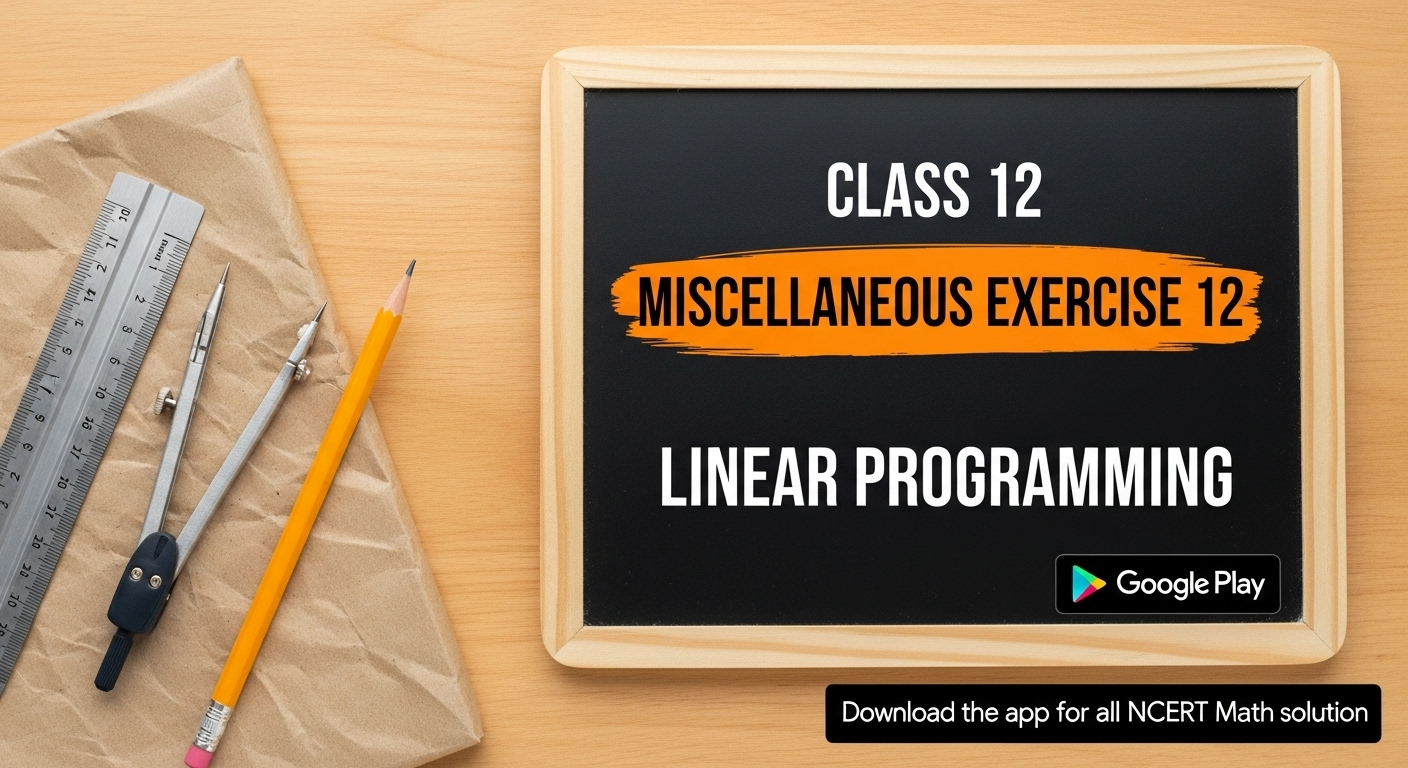
linear programming class 12 ncert solutions || miscellaneous exercise class 12 chapter 12 || miscellaneous exercise class 12 chapter 12 || class 12 maths chapter 12 miscellaneous exercise solutions || ncert solutions for class 12 maths chapter 12 || miscellaneous exercise ch 12 class 12 || miscellaneous exercise chapter 12 class 12 || miscellaneous exercise on chapter 12 class 12
Miscellaneous Exercise
1. Refer to Example 9. How many packets of each food should be used to maximize the amount of vitamin A in the diet? What is the maximum amount of vitamin A in the diet?
Answer
Let \(x\) and \(y\) be the number of packets of food P and Q respectively. Obviously, \( x \geq 0, y \geq 0 \). Mathematical formulation of given problem is as follows:
Maximize \( Z=6 x+3 y \ldots(1)\)
Subject to the constraints,
\( 12 x+3 y \geq 240 \) (constraint on calcium) i.e. \( 4 x+y \geq 80 \ldots(2)\)
\( 4 x+20 y \geq 460 \) (constraint on iron) i.e. \( x+5 y \geq 115 \ldots(3)\)
\( 6 x+4 y \leq 300 \) \(\text{(constraint on cholesterol) i.e.} \ 3 x+2 y \leq 150 \ldots(4)\)
\( x \geq 0, y \geq 0 \ldots(5)\)
Now let us graph the feasible region of the system of inequalities (2) to (5). The feasible region (shaded) is shown in the fig. Here, we can observe that the feasible region is bounded.
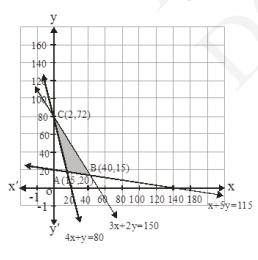
The coordinates of the corner points \( \mathrm{A}(15,20), \mathrm{B}(40,15) \), and \( \mathrm{C}(2,72) \).
\(\begin{array}{|l|l|}
\hline \text{Corner points} & \begin{array}{l}
\text{Corresponding value} \\
of \ Z=6 x+3 y
\end{array} \\
\hline \mathrm{A}(15,20) & 150 \\
\hline \mathrm{B}(40,15) & 285 \rightarrow \text{Maximum} \\
\hline \mathrm{C}(2,72) & 228 \\
\hline
\end{array}\)
Now, we find the maximum value of Z . According to table the maximum value of \( Z=285 \) at point \( B(40,15) \).
Hence, to get the maximum amount of vitamin A in the diet, the packets of food \( P \) should be 40 and the packets of food \( Q \) should be 15 . The maximum amount of vitamin A will be 285.
linear programming class 12 ncert solutions || miscellaneous exercise class 12 chapter 12 || miscellaneous exercise class 12 chapter 12 || class 12 maths chapter 12 miscellaneous exercise solutions || ncert solutions for class 12 maths chapter 12 || miscellaneous exercise ch 12 class 12 || miscellaneous exercise chapter 12 class 12 || miscellaneous exercise on chapter 12 class 12
2. A farmer mixes two brands P and Q of cattle feed. Brand P, costing Rs 250 per bag, contains 3 units of nutritional element A, 2.5 units of element B and 2 units of element C. Brand Q costing Rs 200 per bag contains 1.5 units of nutritional element A, 11.25 units of element B , and 3 units of element C . The minimum requirements of nutrients \( \mathrm{A}, \mathrm{B} \) and C are 18 units, 45 units and 24 units respectively. Determine the number of bags of each brand which should be mixed in order to produce a mixture having a minimum cost per bag? What is the minimum cost of the mixture per bag?
Answer
Let \(x\) and \(y\) be the amount of two bands P and Q respectively which are mixed. Obviously, \( x \geq 0, y \geq 0 \).
The given information can be formulated in a table as:
\(\begin{array}{|l|l|l|l|}
\hline \text{food} & \begin{array}{l}
\text{Vitamin A} \\
\text{(units/kg)}
\end{array} & \begin{array}{l}
\text{Vitamin B} \\
\text{(units/kg)}
\end{array} & \text{Cost (Rs/kg)} \\
\hline \text{P} & 3 & 5 & 60 \\
\hline \text{Q} & 4 & 2 & 80 \\
\hline \begin{array}{l}
\text{Requirements} \\
\text{(units/kg)}
\end{array} & 8 & 11 & \\
\hline
\end{array}\)
Mathematical formulation of given problem is as follows:
Maximize \( Z=250 x+200 y \ldots(1) \)
Subject to the constraints,
\(\begin{array}{l}
3 x+1.5 y \geq 18 \ldots(2)\\
2.5 x+11.25 y \geq 45 \ldots(3)\\
2 x+3 y \geq 24 \ldots (4) \\
x \geq 0, y \geq 0 \ldots (5)
\end{array}\)
Now let us graph the feasible region of the system of inequalities (2) to (5).
The feasible region (shaded) is shown in the fig. Here, we can observe that the feasible region is unbounded.
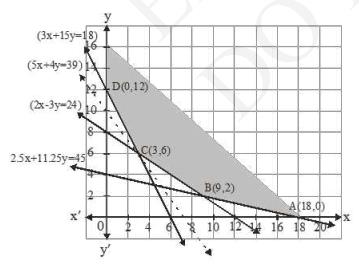
The coordinates of the corner points \( \mathrm{A}(18,0), \mathrm{B}(9,2), \mathrm{C}(3,6) \) and \( \mathrm{D}(0,12) \).
\(\begin{array}{|l|l|}
\hline \text{Corner points} & \text{Corresponding value of} \ z=2 5 0 x+2 0 0 y\\
\hline \mathrm{A}(18,0) & 4500 \\
\hline \mathrm{B}(9,2) & 2650 \\
\hline \mathrm{C}(3,6) & 1950 \rightarrow \text{Minimum} \\
\hline \mathrm{D}(0,12) & 2400 \\
\hline
\end{array}\)
As, feasible region is unbounded so 1950 may or may not be minimum value of \( Z \).
So, 1950 is the minimum value of Z , if the open half plane is determined by \( 250 x+200 y < 1950 \) has no point in common with the feasible region. Otherwise \( z \) has no minimum value.
For this we will draw the graph of inequality \( 250 x+200 y < 1950 \) or \( 5 x+ \) \( 4 y < 39 \). Here we find that \( 250 x+200 y < 1950 \) has no point in common with the feasible region. Hence the minimum value of \( Z \) is 1950 at \( C(3,6) \).
So, 3 and 6 be the amount of two bands P and Q respectively which are mixed to get minimum cost to Rs 1950.
3. A dietician wishes to mix together two kinds of food \( X \) and \( Y \) in such a way that the mixture contains at least 10 units of vitamin \( \mathrm{A}, 12 \) units of vitamin B and 8 units of vitamin C. The vitamin contents of one kg food is given below:
\(\begin{array}{|l|l|l|l|}
\hline \text{Food} & \text{Vitamin A} & \text{Vitamin B} & \text{Vitamin C} \\
\hline\text{X} & 1 & 2 & 3 \\
\hline \text{Y} & 2 & 2 & 1 \\
\hline
\end{array}\)
One kg of food X costs Rs 16 and one kg of food Y costs Rs 20. Find the least cost of the mixture which will produce the required diet?
\(\begin{array}{|l|l|l|l|}
\hline \text{Food} & \text{Vitamin A} & \text{Vitamin B} & \text{Vitamin C} \\
\hline\text{X} & 1 & 2 & 3 \\
\hline \text{Y} & 2 & 2 & 1 \\
\hline
\end{array}\)
One kg of food X costs Rs 16 and one kg of food Y costs Rs 20. Find the least cost of the mixture which will produce the required diet?
Answer
Let \(x\) kg and \(y\) kg be amount of food X and Y respectively. Obviously \( x \geq \) \( 0, y \geq 0 \). Mathematical formulation of given problem is as follows:
Minimize \( Z=16 x+20 y \ldots(1) \)
Subject to the constraints,
\(x+2 y \geq 10\ldots(2)\)
\(x+y \geq 6 \ldots(3)\)
\(3 x+y \geq 8\ldots(4)\)
\(x \geq 0, y \geq 0\ldots(5)\)
Now let us graph the feasible region of the system of inequalities (2) to (5). The feasible region (shaded) is shown in the fig. Here, we can observe that the feasible region is unbounded.
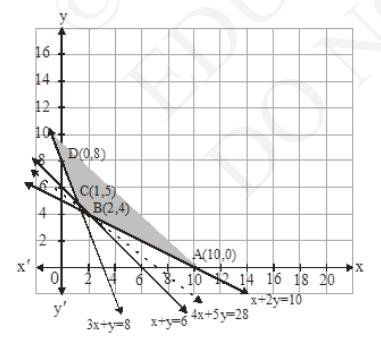
The coordinates of the corner points \( \mathrm{A}(10,0), \mathrm{B}(2,4), \mathrm{C}(1,5) \) and \( \mathrm{D}(0,8) \).
\begin{array}{|l|l|}
\hline \text{Corner points} & \text{Corresponding value of}\ Z=16 x+20 y \\
\hline \mathrm{A}(10,0) & 160 \\
\hline \mathrm{B}(2,4) & 112 \rightarrow \text{Minimum} \\
\hline \mathrm{C}(1,5) & 116 \\
\hline \mathrm{D}(0,8) & 160 \\
\hline
\end{array} As, feasible region is unbounded so 112 may or may not be minimum value of \( Z \).
So, 112 is the minimum value of \( Z \), if the open half plane is determined by \( 16 x+20 y < 112 \) has no point in common with the feasible region. Otherwise z has no minimum value.
For this we will draw the graph of inequality \( 16 x+20 y < 112 \) or \( 4 x+ \) \( 5 y < 28 \). Here we find that \( 16 x+20 y < 112 \) has no point in common with the feasible region. Hence the minimum value of Z is 112 at \( \mathrm{B}(2,4) \).
So, 2 kg and 4 kg be the amount of two foods P and Q respectively which are mixed to get minimum cost to Rs 112.
4. A manufacturer makes two types of toys A and B . Three machines are needed for this purpose and the time (in minutes) required for each toy on the machines is given below:
\(\begin{array}{|l|l|l|l|}
\hline \text{Types of toyes} & \text{Machines} \\
\hline & I & II & III \\
\hline \mathrm{A} & 12 & 18 & 6 \\
\hline \mathrm{B} & 6 & 0 & 9 \\
\hline
\end{array}\)
Each machine is available for a maximum of 6 hours per day. If the profit on each toy of type A is Rs 7.50 and that on each toy of type B is Rs 5, show that 15 toys of type A and 30 of type B should be manufactured in a day to get maximum profit.
\(\begin{array}{|l|l|l|l|}
\hline \text{Types of toyes} & \text{Machines} \\
\hline & I & II & III \\
\hline \mathrm{A} & 12 & 18 & 6 \\
\hline \mathrm{B} & 6 & 0 & 9 \\
\hline
\end{array}\)
Each machine is available for a maximum of 6 hours per day. If the profit on each toy of type A is Rs 7.50 and that on each toy of type B is Rs 5, show that 15 toys of type A and 30 of type B should be manufactured in a day to get maximum profit.
Answer
Let \( x \) and \( y \) be the number of toys manufactured per day of type \( A \) and \( B \) respectively. Obviously \( x \geq 0, y \geq 0 \). Mathematical formulation of given problem is as follows:
Maximize \( Z=7.5 x+5 y\ldots(1) \)
Subject to the constraints,
\(2 x+y \leq 60 \ldots(2)\)
\(x \leq 60 \ldots \ldots(3)\)
\(2 x+3 y \leq 120\ldots(4)\)
\(x \geq 0, y \geq 0 \ldots(5)\)
Now let us graph the feasible region of the system of inequalities (2) to (5). The feasible region (shaded) is shown in the fig. Here, we can observe that the feasible region is bounded.
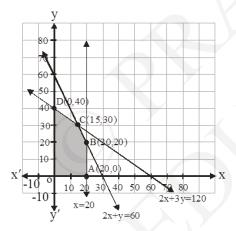
The coordinates of the corner points \( A(20,0), B(20,20), C(15,30) \) and \( \mathrm{D}(0,40) \).
\(\begin{array}{|l|l|}
\hline \text{Corner points} & \text{corresponding value of} \ Z=7,5 x+5 y \\
\hline \mathrm{A}(20,0) & 150 \\
\hline \mathrm{B}(20,20) & 250 \\
\hline \mathrm{C}(15,30) & 262.5 \rightarrow \text{Maximum} \\
\hline \mathrm{D}(0,40) & 200 \\
\hline
\end{array}\)
Now, we find the maximum value of Z. According to table the maximum value of \( Z=262.5 \) at point \( C(15,30) \).
Hence, 15 and 20 be the number of toys manufactured per day of type A and \( B \) respectively to get the maximum profit.
5. An aeroplane can carry a maximum of 200 passengers. A profit of Rs 1000 is made on each executive class ticket and a profit of Rs 600 is made on each economy class ticket. The airline reserves at least 20 seats for executive class. However, at least 4 times as many passengers prefer to travel by economy class than by the executive class. Determine how many tickets of each type must be sold in order to maximise the profit for the airline. What is the maximum profit?
Answer
Let \( x \) and \( y \) be the number of tickets of executive class and economy class respectively. Obviously \( x \geq 0, y \geq 0 \). Mathematical formulation of given problem is as follows:
Maximize \( Z=1000 x+600 y \ldots(1)\)
Subject to the constraints,
\(x+y \leq 200\ldots(2)\)
\(x \geq 20 \ldots(3)\)
\(y-4 x \geq 0\ldots(4)\)
\(x \geq 0, y \geq 0\ldots(5)\)
Now let us graph the feasible region of the system of inequalities (2) to (5). The feasible region (shaded) is shown in the fig. Here, we can observe that the feasible region is
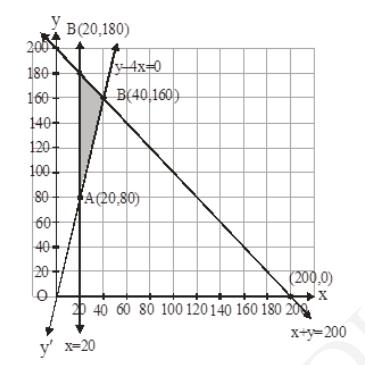
The coordinates of the corner points \( \mathrm{A}(20,80), \mathrm{B}(40,160) \) and \( \mathrm{C}(20,180) \).
\(\begin{array}{|l|l|}
\hline \text{Corner points} & \text{Corresponding value of} \ Z=1000 x+600 y \\
\hline \mathrm{A}(20,80) & 68000 \\
\hline \mathrm{B}(40,160) & 136000 \rightarrow \text{Maximum} \\
\hline \mathrm{C}(20,180) & 128000 \\
\hline
\end{array}\)
Now, we find the maximum value of \( Z \). According to table the maximum value of \( Z=136000 \) at point \( B(40,160) \).
Hence, 40 and 160 be the number of tickets of executive class and economy class respectively to get the maximum profit.
6. Two godowns A and B have grain capacity of 100 quintals and 50 quintals respectively. They supply to 3 ration shops, D, E and F whose requirements are 60,50 and 40 quintals respectively. The cost of transportation per quintal from the godowns to the shops are given in the
\(\begin{array}{|l|l|l|}
\hline \text{Transportation cost per quintal (in Rs)} \\
\hline \text{From/To} & \text{A} & \text{B} \\
\hline D & 6 & 4 \\
\hline E & 3 & 2 \\
\hline F & 2.50 & 3 \\
\hline
\end{array}\)
How should the supplies be transported in order that the transportation cost is minimum? What is the minimum cost?
\(\begin{array}{|l|l|l|}
\hline \text{Transportation cost per quintal (in Rs)} \\
\hline \text{From/To} & \text{A} & \text{B} \\
\hline D & 6 & 4 \\
\hline E & 3 & 2 \\
\hline F & 2.50 & 3 \\
\hline
\end{array}\)
How should the supplies be transported in order that the transportation cost is minimum? What is the minimum cost?
Answer
let \(x\) and \(\)y quintal of grain supplied by A to shop d and E respectively. Then \( 100-x-y \) will be supplied to shop F. Obviously \( x \geq 0, y \geq 0 \).
Since requirement at shop D is 60 quintal but supplied x quintal hence, 60 -x is sent form B to \( D \).
Similarly requirement at shop \( E \) is 50 quintal but supplied y quintal hence, \( 50-y \) is sent form \( B \) to \( E \).
Similarly requirement at shop E is 40 quintal but supplied \( 100-x-y \) quintal hence, \( 40-(100-x-y) \) i.e. \( x+y-60 \) is sent form \( B \) to \( E \).
Diagrammatically it can be explained as:

As \( x \geq 0, y \geq 0 \) and \( 100-x-y \geq 0 \Rightarrow x+y \leq 100 \)
\( 60-x \geq 0,50-y \geq 0 \) and \( x+y-60 \geq 0 \)
\( \Rightarrow x \leq 60, y \leq 50 \) and \( x+y \geq 60 \)
Total transportation cost Z can be calculated as:
\(\begin{array}{l}
Z=6 x+3 y+2.5(100-x-y)+4(60-x)+2(50-y)+3(x+y-60) \\
=6 x+3 y+250-2.5 x-2.5 y+240-4 x+100-2 y+3 x+3 y-180 \\
Z=2.5 x+1.5 y+410
\end{array}\)
Mathematical formulation of given problem is as follows:
Minimize \( Z=2.5 x+1.5 y+410 \ldots(1) \)
Subject to the constraints,
\(x+y \leq 100 \ldots(2)\)
\(x \leq 60 \ldots \ldots(3)\)
\(y \leq 50 \ldots(4)\)
\(x+y \geq 60\ldots(5)\)
\(x \geq 0, y \geq 0\ldots(6)\)
Now let us graph the feasible region of the system of inequalities (2) to (6). The feasible region (shaded) is shown in the fig. Here, we can observe that the feasible region is bounded.
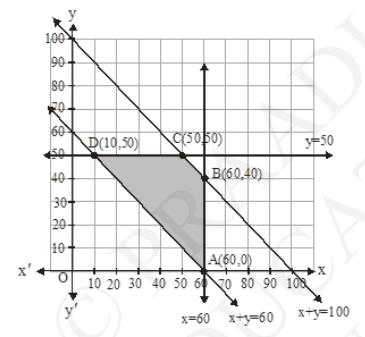
\( \text{The coordinates of the corner points } \mathrm{A}(60,0), \mathrm{B}(60,40), \mathrm{C}(50,50) \) and \( \mathrm{D}(10,50) \).
\(\begin{array}{|l|l|}
\hline \text{Corner points} & \text{Corresponding value of} \ Z=2.5 x+1.5 y+410 \\
\hline \mathrm{A}(60,0) & 560 \\
\hline \mathrm{B}(60,40) & 620 \\
\hline \mathrm{C}(50,50) & 610 \\
\hline \mathrm{D}(10,50) & 510 \rightarrow \text{Minimum} \\
\hline
\end{array}\)
Now, we find the minimum value of Z. According to table the minimum value of \( Z=510 \) at point \( D(10,50) \).
Hence, the amount of grain delivered from A to \( \mathrm{D}, \mathrm{E} \) and F is 10 quintal, 50 quintals and 40 quintals respectively and from \( B \) to \( \mathrm{D}, \mathrm{E} \) and F is 50 quintal, 0 quintal and 0 quintal respectively.
linear programming class 12 ncert solutions || miscellaneous exercise class 12 chapter 12 || miscellaneous exercise class 12 chapter 12 || class 12 maths chapter 12 miscellaneous exercise solutions || ncert solutions for class 12 maths chapter 12 || miscellaneous exercise ch 12 class 12 || miscellaneous exercise chapter 12 class 12 || miscellaneous exercise on chapter 12 class 12
7. An oil company has two depots A and B with capacities of 7000 L and 4000 L respectively. The company is to supply oil to three petrol pumps, D, E and F whose requirements are \( 4500 \mathrm{~L}, 3000 \mathrm{~L} \) and 3500 L respectively. The distances (in km ) between the depots and the petrol pumps is given in the following table:
\(\begin{array}{|l|l|l|}
\hline \text{Distances (in km)} \\
\hline \text{From/To} & \mathrm{A} & \mathrm{B} \\
\hline \mathrm{D} & 7 & 3 \\
\hline \mathrm{E} & 6 & 4 \\
\hline \mathrm{F} & 3 & 2 \\
\hline
\end{array}\)
Assuming that the transportation cost of 10 liters of oil is Re 1 per km, how should the delivery be scheduled in order that the transportation cost is minimum? What is the minimum cost?
\(\begin{array}{|l|l|l|}
\hline \text{Distances (in km)} \\
\hline \text{From/To} & \mathrm{A} & \mathrm{B} \\
\hline \mathrm{D} & 7 & 3 \\
\hline \mathrm{E} & 6 & 4 \\
\hline \mathrm{F} & 3 & 2 \\
\hline
\end{array}\)
Assuming that the transportation cost of 10 liters of oil is Re 1 per km, how should the delivery be scheduled in order that the transportation cost is minimum? What is the minimum cost?
Answer
Let \( x \) and \( y \) liters of oil be supplied by A to shop D and E respectively. Then 7000 - \( x-y \) will be supplied to F . Obviously \( x \geq 0, y \geq 0 \).
Since requirement at D is 4500 L but supplied \(x\) quintal hence, \( 4500-x \) is sent form B to D.
Similarly requirement at E is 3000 L but supplied y quintal hence, 3000-y is sent form B to E.
Similarly requirement at \( E \) is 3500 quintal but supplied \( 7000-x-y \) quintal hence, \( 3500-(7000-x-y) \) i.e. \( x+y-3500 \) is sent form \( B \) to \( E \).
Diagrammatically it can be explained as:
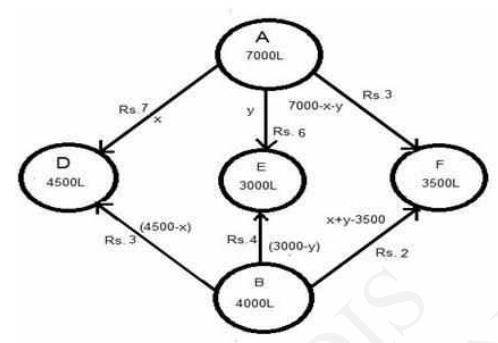
As \( x \geq 0, y \geq 0 \) and \( 7000-x-y \geq 0 \Rightarrow x+y \leq 7000 \)
\( 4500-x \geq 0,3000-y \geq 0 \) and \( x+y-3500 \geq 0 \)
\( \Rightarrow x \leq 4500, y \leq 3000 \) and \( x+y \geq 3500 \)
Cost of delivering 10L of petrol \( = \) Rs. 1
Then Cost of delivering 1 L of petrol = Rs. \( \frac{1} {10} \)
Total transportation cost Z can be calculated as:
\(Z=\frac{7}{10} x+\frac{6}{10} y+\frac{3}{10}(7000-x-y)+\frac{3}{10}(4500-x)+\frac{4}{10}(3000-y)+\frac{2}{10}(x +y-3500)\)
\(Z=0.3 x+0.1 y+3950\)
Mathematical formulation of given problem is as follows:
Minimize \( Z=0.3 x+0.1 y+3950 \ldots(1)\)
Subject to the constraints,
\(x+y \leq 7000\ldots(2)\)
\(x \leq 4500\ldots(3)\)
\(y \leq 3000\ldots(4)\)
\(x+y \geq 3500\ldots(5)\)
\(x \geq 0, y \geq 0\ldots(6)\)
Now let us graph the feasible region of the system of inequalities (2) to (6). The feasible region (shaded) is shown in the fig. Here, we can observe that the feasible region is bounded.
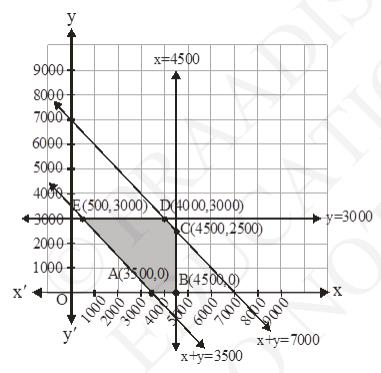
\( \text{The coordinates of the corner points} \ \mathrm{A}(3500,0), \mathrm{B}(4500,0), \mathrm{C}(4500,2500) \), \( \mathrm{D}(4000,3000) \) and \( \mathrm{E}(500,3000) \).
\(\begin{array}{|l|l|}
\hline \text{Corner points} & \text{Corresponding value of} \ Z=0 . 3 x+0 . 1 y+3 9 5 0 \\
\hline \mathrm{A}(3500,0) & 5000 \\
\hline \mathrm{B}(4500,0) & 5300 \\
\hline \mathrm{C}(4500,2500) & 5550 \\
\hline \mathrm{D}(4000,30000 & 5450 \\
\hline \mathrm{E}(500,3000) & 4400 \rightarrow \text{Minimum} \\
\hline
\end{array}\)
Now, we find the minimum value of Z . According to table the minimum value of \( Z=4400 \) at point \( E(500,3000) \).
Hence, the amount of oil delivered from A to D, E and F is 500L, 3000L and 3500L quintals respectively and from B to \( \mathrm{D}, \mathrm{E} \) and F is \( 4000 \mathrm{~L}, 0 \mathrm{~L} \) and 0 L respectively.
8. A fruit grower can use two types of fertilizer in his garden, brand P and brand Q . The amounts (in kg ) of nitrogen, phosphoric acid, potash, and chlorine in a bag of each brand are given in the table. Tests indicate that the garden needs at least 240 kg of phosphoric acid, at least 270 kg of potash and at most 310 kg of chlorine.
If the grower wants to minimise the amount of nitrogen added to the garden, how many bags of each brand should be used? What is the minimum amount of nitrogen added in the garden?
\(\begin{array}{|l|l|l|}
\hline \text{kg per bag} &
\text{Brand P} & \text{Brand Q} \\
\hline \text{Nitrogen} & 3 & 3.5 \\
\hline \text{Phosphoric acid} & 1 & 2 \\
\hline \text{Potash} & 3 & 1.5 \\
\hline \text{Chlorine} & 1.5 & 2 \\
\hline
\end{array}\)
If the grower wants to minimise the amount of nitrogen added to the garden, how many bags of each brand should be used? What is the minimum amount of nitrogen added in the garden?
\(\begin{array}{|l|l|l|}
\hline \text{kg per bag} &
\text{Brand P} & \text{Brand Q} \\
\hline \text{Nitrogen} & 3 & 3.5 \\
\hline \text{Phosphoric acid} & 1 & 2 \\
\hline \text{Potash} & 3 & 1.5 \\
\hline \text{Chlorine} & 1.5 & 2 \\
\hline
\end{array}\)
Answer
let \(x\) and \(y\) be the bags of brands P and Q respectively. Obviously \( x \geq 0, y \) \( \geq 0 \). Mathematical formulation of given problem is as follows:
Minimize \( z=3 x+3.5 y\ldots(1) \)
Subject to the constraints,
\(x+2 y \leq 240 \ldots(2)\)
\(3 x+1.5 y \leq 270 \Rightarrow x+0.5 y=90\ldots(3)\)
\(1.5 x+2 y \leq 310 \ldots(4)\)
\(x \geq 0, y \geq 0 \ldots(5)\)
Now let us graph the feasible region of the system of inequalities (2) to (5). The feasible region (shaded) is shown in the fig. Here, we can observe that the feasible region is bounded.
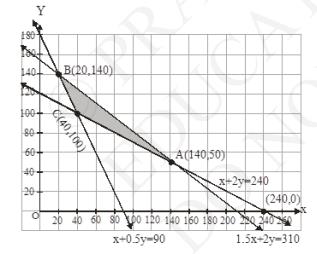
The coordinates of the corner points \( \mathrm{A}(140,50), \mathrm{B}(20,40) \) and \( \mathrm{C}(40,100) \).
\(\begin{array}{|l|l|}
\hline \text{corner points} & \text{Corresponding value of} \ z=3 x+3.5 y \\
\hline \mathrm{A}(140,50) & 595 \\
\hline \mathrm{B}(20,40) & 55 \\
\hline 0 \mathrm{C}(40,100) & 470 \rightarrow \text{Minimum} \\
\hline
\end{array}\)
Now, we find the minimum value of Z . According to table the minimum value of \( Z=470 \) at point \( C(40,100) \).
Hence, 40 and 100 be the bags of brands P and Q respectively to be added to the garden to minimize the amount of nitrogen.
9. Refer to Question 8. If the grower wants to maximise the amount of nitrogen added to the garden, how many bags of each brand should be added? What is the maximum amount of nitrogen added?
Answer
Let \(x\) and \(y\) be the bags of brands P and Q respectively. Obviously \( x \geq 0, y \) \( \geq 0 \). Mathematical formulation of given problem is as follows:
Maximize \( z=3 x+3.5 y\ldots(1) \)
Subject to the constraints,
\(x+2 y \leq 240 \ldots(2)\)
\(3 x+1.5 y \leq 270 \Rightarrow x+0.5 y=90\ldots(3)\)
\(1.5 x+2 y \leq 310 \ldots(4)\)
\(x \geq 0, y \geq 0 \ldots(5)\)
Now let us graph the feasible region of the system of inequalities (2) to (5). The feasible region (shaded) is shown in the fig. Here, we can observe that the feasible region is bounded.
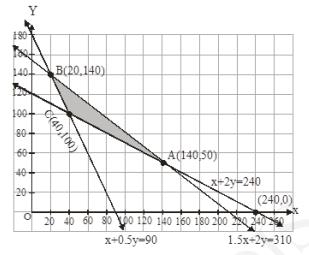
The coordinates of the corner points \( \mathrm{A}(140,50), \mathrm{B}(20,40) \) and \( \mathrm{C}(40,100) \).
\(\begin{array}{|l|l|}
\hline \text{corner points} & \text{Corresponding value of} \ z=3 x+3.5 y \\
\hline \mathrm{A}(140,50) & 595 \rightarrow \text{Maximum} \\
\hline \mathrm{B}(20,40) & 550 \\
\hline \mathrm{C}(40,100) & 470 \\
\hline
\end{array}\)
Now, we find the maximum value of Z. According to table the maximum value of \( Z=595 \) at point \( \mathrm{A}(140,50) \).
Hence, 140 and 50 be the bags of brands P and Q respectively to be added to the garden to maximize the amount of nitrogen.
10. A toy company manufactures two types of dolls, A and B. Market tests and available resources have indicated that the combined production level should not exceed 1200 dolls per week and the demand for dolls of type B is at most half of that for dolls of type A. Further, the production level of dolls of type A can exceed three times the production of dolls of other type by at most 600 units. If the company makes profit of Rs 12 and Rs 16 per doll respectively on dolls A and B , how many of each should be produced weekly in order to maximise the profit?
Answer
Let \(x\) and \(y\) be the number of dolls of type A and B respectively. Obviously \( x \geq 0, y \geq 0 \). Mathematical formulation of given problem is as follows:
Maximize \( Z=12 x+16 y \ldots(1)\)
Subject to the constraints,
\(x+y \leq 1200 \ldots(2)\)
\(y \leq \frac{x}{2} \Rightarrow 2 y \leq x\ldots(3)\)
\(x-3 y \leq 600 \ldots(4)\)
\(x \geq 0, y \geq 0 \ldots(5)\)
Now let us graph the feasible region of the system of inequalities (2) to (5). The feasible region (shaded) is shown in the fig. Here, we can observe that the feasible region is bounded.
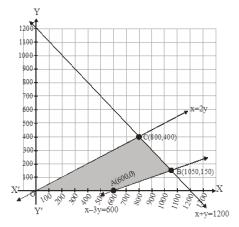
The coordinates of the corner points \( \mathrm{A}(600,0), \mathrm{B}(1050,150) \) and \( \mathrm{C}(800,400) \).
\(\begin{array}{|l|l|}
\hline \text{corner points} & \text{Corresponding value of} \ z=12 x+16 y \\
\hline \mathrm{A}(600,0) & 7200 \\
\hline \mathrm{B}(1050,150) & 15000 \\
\hline \mathrm{C}(800,400) & 16000 \rightarrow \text{Maximum} \\
\hline
\end{array}\)
Now, we find the maximum value of Z. According to table the maximum value of \( Z=16000 \) at point \( C(800,400) \).
Hence, 800 and 400 be the number of dolls of type A and B respectively.
